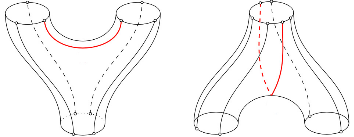Algebraic Model of String Operations
Author
Pavel Hajek
Title
Algebraic Model of String Operations
Description
The operations of joining and disjoining of strings have an algebraic model as a bi-Lie algebra
Category
Working Material
Keywords
Involutive bi-Lie algebra (IBL), graded algebra, algebraic model of string operations, string field theory
URL
http://www.notebookarchive.org/2024-07-6ij9go2/
DOI
https://notebookarchive.org/2024-07-6ij9go2
Date Added
2024-07-14
Date Last Modified
2024-07-14
File Size
464.28 kilobytes
Supplements
Rights
Redistribution rights reserved

Algebraic Model of String Operations
Algebraic Model of String Operations
Pavel Hajek
The operations of joining and disjoining of strings have an algebraic model as a bi-Lie algebra
Explanation And Example
Explanation And Example
The "interaction diagrams" below represent the operations of joining and disjoining of closed strings which are modeled as "bracelets of particles":

The direction of propagation is from the top to the bottom. Each red curve represents an "interaction" that amounts to a pairing that annihilates two particles and produces a scalar coefficient. There is precisely one pair of interacting particles in each diagram. The resulting strings are read off from the bottom boundary components of the depicted surfaces. If we denote the vector space generated by all strings as W, then the vector space generated by all pairs of strings is the tensor product W W, and the diagrams correspond to a bracket μ: W W ⟶ W and a co-bracket δ: W ⟶ W W, respectively. In order to get independence of the choice of a particular diagram, we define the operations as sums over all permutations of input strings and all cyclic permutations of particles on each string. We can even do it in the "supersymmetric case", where each particle has an integer degree, by carefully employing a natural sign convention. In (CFL) it was shown that if the pairing is (graded) anti-symmetric and has degree d ∈ Z, then μ and δ satisfy the relations of an involutive bi-Lie algebra (IBL) of degree d. In particular, μ and δ are (graded) anti-symmetric with respect to the degree of a string computed as a sum of degrees of its particles plus d. The IBL relations can be schematically depicted as follows:

Each figure depicts a glued surface, which is interpreted as a composition of operations. The cylinder represents the identity. Algebraic relations are obtained by summing over all possible insertions of incoming strings in the top boundary components and all possible compositions of the operations that lead to the same surface.
We consider the following example of one "fermion" x and one "boson" y:
In[]:=
degrees=<|"x"->-1,"y"->0|>;pairing=<|{"x","y"}->1,{"y","x"}->-1,{"x","x"}->0,{"y","y"}->0|>;
The bracket and co-bracket of strings build from x and y can be computed in the following way:
In[]:=
{bracket["xy","yyyy"],cobracket["xyyyy"]}//Column
The anti-symmetry of δ allows us to write the result as a sum of wedge products. By sending a wedge product ⋀…⋀ to the sum ± … , which can be seen as the sum of applications of δ to the numerators of the wedge product in all possible ways, we obtain a linear operation on the exterior algebra ΛW of W. Likewise, using the anti-symmetry of μ, we obtain a linear operation on ΛW by sending ⋀…⋀ to … … ⋀ . The notebook can evaluate arbitrary compositions of , , and ⋀:
w
1
w
k
∑
i
δ()⋀⋀…
w
i
w
1
w
i
⋀
w
k
δ
μ
w
1
w
k
∑
i,j
±μ(,)⋀⋀…
w
i
w
j
w
1
w
i
w
j
w
k
δ
μ
In[]:=
bracket[wedge[cobracket["xyyyyyy"],wedge["x","y"]]]//Simplify
We can write and in the following succinct forms, respectively:
μ
δ
In[]:=
{bracket["xyyy","xyy","y"],cobracket["xyyyy","xyxyxyxx","yyyxxyyyy"]}//Column
The IBL relations can be probed as follows:
In[]:=
{jacobi["xy","xy","yyy"],cojacobi["xyxyxxxy"],drinfeld["xyxyx","yyyxxy"],involutivity["xyxxxyxxy"]}//Column
We can run automatic tests of the IBL relations on all strings of length ≤ n:
In[]:=
{testJacobi[3],testCojacobi[5],testDrinfeld[3],testInvolutivity[5]}
Here the test functions are written such that they would return wedge products of strings for which the respective relations would not hold.
Finally, let us remark that the IBL operations presented above play an important role in the formulation of string field theory (a quantum theory of strings). My plan is to extend this example to involve more aspects of string field theory, in particular the BV formalism and deformation theory.
Code
Code
The initial data - the pairing and the degrees of particles - can be modified provided that the following requirements are satisfied:
A particle corresponds to a single letter, the pairing has a well-defined degree, and the pairing is graded anti-symmetric.
The pairing can be specified only partially as long as it is possible to deduce it for each pair of particles using the graded anti-symmetry.
In[]:=
Additional Information
Additional Information
Contributed By
Contributed By
Pavel Hajek
Keywords
Keywords
◼
involutive bi-Lie algebra (IBL)
◼
graded algebra
◼
algebraic model of string operations
◼
string field theory
References
References
◼
The original blog post of this implementation:
◼
The IBL relations were proven in the following paper:
◼
The history of string operations and IBL relations goes back to the following seminal work:
◼
My PhD thesis elaborates on this topic as well:
Links
Links
◼
Author Notes
Author Notes
◼
"Mixed inputs" like bracket[wedge[“x”,”y”],”y”] are currently not supported. Instead, wrap everything in wedge: bracket[wedge[wedge[“x”,”y”],”y"]].
Cite this as: Pavel Hajek, "Algebraic Model of String Operations" from the Notebook Archive (2024), https://notebookarchive.org/2024-07-6ij9go2
Download
